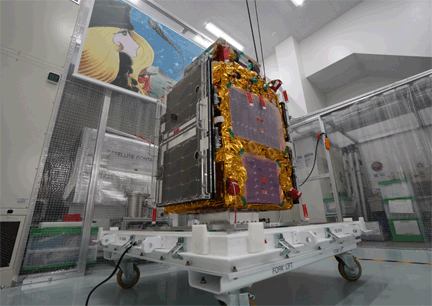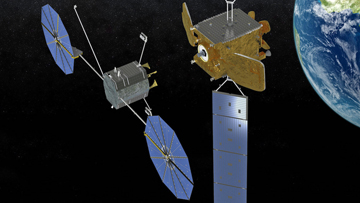State of the Art: On-Orbit Services
by Elisabeth Tweedie
Los Angeles, Calif., June 4, 2021--Many years ago, when I was part of a team considering an investment in Teledesic, one of the engineers at Hughes, produced a computer model, of what would happen if one of the satellites ran into a piece of orbital debris. The assumption was, that this would cause it to break-up, so the satellite behind would inevitably run into the fragments and similarly break-up and so on. The space equivalent of a freeway pile-up, technically known as the Kessler Effect, after the NASA scientist who first modeled this happening.
Teledesic, in common with many of the other Low Earth Orbit (LEO) and Medium Earth Orbit (MEO) systems on the drawing board at the time, didn’t get off the ground, and general interest in space debris faded.
Space Debris
Space debris, however did not go away, it continued to grow. According to NASA there are at least 26,000 pieces of debris greater than 10 centimeters long, including discarded payloads and rocket remains. All of these have the potential to destroy a satellite on impact. In addition, there are around 500,000 smaller objects, about the size of a marble, which would damage a satellite if a collision occurred. As more and more LEO satellites are being launched interest in the subject is increasing, fueled in no small way, by a number of near – and a few actual – collisions in recent years; not to mention Chinese rockets in free fall, with no designated landing spot. There is a genuine fear, amongst those who have studied the situation, that with the vast numbers of satellites now being launched, unless we adopt a more responsible and united approach to managing space assets, the Kessler Effect, won’t just be a theory. In the most extreme case, a major collision has the potential not only to knock out the satellites directly impacted, but to create so much debris as to render space inaccessible.
Fortunately, we are well past the stage of pure academic interest in the subject. In recent years a new industry of On-Orbit-Services (OOS), also known as In-Orbit-Services (IoS)) has been born. Debris removal is one aspect of OOS, Mission Extension, in-orbit repair and upgrade, manufacturing in space and ride-to-orbit are others.
One of the main problems with orbital debris, apart from its existence, is that it has the potential to be a problem for everyone, but no one has ownership of the problem. This makes it really hard to close a business case for its removal, without international cooperation and funding, which isn’t there yet.
“Future Proofing Space”
Astroscale has taken an alternative approach, and is focusing its initial efforts on preventing future debris. Astroscale is a young Japan-bansed company with offices in the UK, US and Israel. John Auburn, Group Chief Commercial Officer and Managing Director, UK described the company’s mission as “Future Proofing Space.” To that end, the company has several products in the pipeline aiming to deal with different aspects of preserving space for future generations. The most advanced of these, is End of Life Services by Astroscale, otherwise known as ELSA. ELSA-d, the demonstration satellite for this service, was launched in March of this year and will begin maneuvers this summer. This service is to retrieve LEOs at their end of life, move them to a lower orbit, then release them so they burn up. In order to be retrieved, the LEO has to be equipped with a magnetic docking plate. The latest batch of OneWeb satellites are equipped with this plate, and according to Auburn, Astroscale is in discussions with other operators. ELSA-d, will release a dummy satellite equipped with this plate and attempt several different methods of retrieving it.
 |
|
Astroscale’s End of Life Services demonstration satellite ELSA-d being prepared for delivery to the launch site. (image courtesy of Asroscale) |
Assuming that all goes according to plan and the “satellite” is retrieved, the next mission, ELSA-m is planned for 2024. “m” stands for multi-client. ELSA-m will retrieve a defunct LEO satellite, bring it down to a lower altitude where it will be released for burn-up, then return to the LEO orbit to pick-up another. The aim is to retrieve and remove two or three satellites with each mission.
Obviously, developing the technology to do this, has not been without its challenges. As Auburn said: “No one has ever tried to rendezvous with a satellite traveling at about 17,000 mph hour before.” LEO satellites orbit the earth in 80-120 minutes depending on their altitude and orbit. A GEO orbits the earth in 24 hours, traveling at approximately 7,000 mph. “So the challenge, has been to develop the agility to maneuver very quickly, and the ability to abort should something go wrong.” ELSA-d is operating under a license from the British Government, through the UK Space Agency, so the ultimate risk, rests with it.”
The company also has plans for active debris removal (ADR). It has been selected by JAXA the Japan Aerospace Exploration Agency as the commercial partner for the first phase of its Commercial Removal of Debris Demonstration (CRD2) project. In 2023 Astroscale Japan, plans to launch a satellite to go and inspect a piece of debris, one contender for this is the upper stage rocket of JAXA-H2. This satellite (ADRAS-J) will get within 100 meters of the rocket and fly around it, photographing it every 30 seconds. The objective is to identify the best way to grab the rocket, so it can be removed during a follow-up mission. For this sector of its business, Astroscale is focused on working with national space agencies and international organizations.
Multiple studies, many funded by NASA, have concluded that the growth of debris in LEO can be slowed by ensuring that at least 90 percent of all spacecraft are removed from orbit within 25 years of the end of their mission, and at least five defunct spacecraft (that will not deorbit on their own) are actively removed from orbit every year. These are the two markets that Astroscale is targeting.
Mission Extension Vehicles
At GEO orbit, debris is less of an issue, there isn’t as much of it, and the satellites are widely spaced, and all in the same orbital plane. There are however, a number of otherwise perfectly good satellites coming to their end-of-life as they run out of fuel. Historically, these have all been “retired” and relocated to a graveyard orbit. Now there is another option. SpaceLogistics LLC, a wholly-owned Northrop Grumman company, has successfully launched two Mission Extension Vehicles (MEVs), and attached them to Intelsat satellites, giving them another five years of life. The first of these, MEV-1 docked with IS-901 in February 2020.
 |
| Artist renidtion of the historic mission by SpaceLogistics where their MEV-1 vehicle successful docked into the Intelsat 901 satellite to perform life extension services, prolonging the service life of the satellite. (Image courtesy of NASA Spaceflight.com) |
This was not only a momentous occasion for the industry, it was also one for Joe Anderson, VP, SpaceLogistics. In 2001 when the satellite waslaunched, Anderson was working for Intelsat, and was part of the launch team, which made him one of the last people to see IS-901. As MEV-1 was approaching IS-901 it sent photos back to earth. These were the first ever photos taken of a satellite in orbit (albeit a graveyard orbit in this case). Anderson, of course was there in the control room, making him one of the first, as well one of the last people to see this satellite. A truly unique experience!
Once MEV-1 was safely attached to IS-901, on-orbit maneuvers were checked, before the satellite was maneuvered back into position in the geostationary arc, and returned to service for another five years, after which it will be returned to, and dropped off in a graveyard orbit. MEVs have a design life of 15 years, and potentially could service up to ten satellites, depending on the needs of each customer. MEVs provide attitude control and on-orbit station keeping. Having proved that a MEV can successfully attach to a satellite, in April of this year, MEV-2 was attached to IS-1002 in its working location. The docking is controlled from the ground, up until the last meter, when autonomous systems kicks in. Once docking is complete, ground control takes over again. MEV was named “The satellite technology of the year” for 2021 by Via Satellite.
SpaceLogistics’ plans for OOS, go way beyond MEV. The next step is Mission Robotic Vehicles (MRVs). Defense Advanced Research Projects Agency (DARPA) will supply the robotics to be integrated into these vehicles. The first MRV will launch in 2024, and will be equipped with a robotic arm, supplied by DARPA. This is a win-win situation for both parties. DARPA gets a permanent presence for its Robotic Servicing of Geosynchronous Satellites (RSGS) program: SpaceLogistics, which will run the business, gets use of the robotic arm, which will be used for repairs, to install augmentation devices, capture and relocate satellites and eventually even remove large debris, such as small satellites. But maybe the immediate, most important function of its MRV for SpaceLogistics, is for the installation of Mission Extension Pods (MEPs). These are being designed to provide sufficient fuel for an additional six years life for an average GEO, more for a lighter weight one. If a satellite operator wanted to, a MEP could divide its time between two of its satellites, although fuel would obviously be used during relocation. SpaceLogistics has customers and term-sheets for five of these – all for different commercial satellite operators. These fill the launch manifest up to the second half of 2025. The MEP is a smaller, less expensive extension vehicle, that only provides on orbit station keeping.
MEVs and MEPs are both designed to extend the life of satellites that weren’t designed to be serviced. The next step in SpaceLogistics’ road map, is to service satellites equipped with standard features that facilitate servicing. Grapple fixtures, fiducials, standard refueling ports and even USB slots so that a failed piece of equipment could be replaced, or new capabilities added. It’s SpaceLogistics’ vision that by 2025 every satellite launched will have these features. This means, for example, that in the future, the MRV instead of carrying and attaching a MEP, could carry fuel which would be used to “top-up” the satellite. Alternatively, these satellites could potentially be launched with minimum fuel making for a lighter and therefore cheaper launch, to be refueled by the MRV soon after launch. Obviously, this is a financial trade-off that needs to studied.
Looking even more to the future, Anderson is planning in-orbit manufacturing and assembly. He pointed out that: “most of the constraints on satellites today, are due the launch environment and the size of the payload fairings. Up to 70% of the mass of a satellite, is there to support the launch. If the satellite is assembled or even manufactured, in space this constraint is removed, so there would be a paradigm shift in the design of satellites.”
None of this is as farfetched as it may sound. 3D printing has been carried out on the International Space Station (ISS) and NASA has plans for two demonstrations of in-orbit manufacturing. The first On-orbit Servicing, Assembly, and Manufacturing (OSAM-1) satellite, has just finished its critical design review (CDR). As well as attaching a refueling payload to Landsat 7, a US government satellite, OSAM-1 will demonstrate in-space assembly and manufacturing. The OSAM-1 bus will incorporate a Space Infrastructure Dexterous Robot (SPIDER) to assemble an antenna. The bus and SPIDER are being built by Maxar. A third element, known as MakerSat, built by Tethers Unlimited (TUI), will manufacture a carbon fiber 2x4 beam. In the future this capability could be used to assemble very large structures to support antennas, solar sails, solar arrays etc.. TUI was also one of the companies responsible for a 3D printing demonstration on the ISS. The company is also aiming to recycle in space and is looking for ways to reuse, some of the debris that is floating around.*
The second NASA mission, OSAM-2 will for the first time, have a satellite manufacture its own solar array in space. OSAM -2 is currently expected to launch in 2023-4 timeframe. Once positioned in orbit, the small satellite will print two beams that will extend approximately 33 feet from each side of the spacecraft. As the manufacturing of these beams continues, they will unfurl solar arrays that will generate up 5x more power than traditional solar panels on a similar sized satellite. These will be made by Made in Space a Redwire company. Made in Space is another company that has been demonstrating 3D printing on the ISS.
Consortium for Execution of Rendezvous and Servicing Operations
Anderson is very much in favor of establishing open standards for on-orbit servicing, manufacturing and assembly. To that end, SpaceLogistics is a member of The Consortium for Execution of Rendezvous and Servicing Operations (CONFERS). This is an industry led initiative, initially set up by DARPA, expressly to establish consensus-derived technical, operational and hardware standards for OOS and Rendezvous and Proximity Operations (RPO). There is also a regulatory arm of the organization, working to help, educate and inform national regulators about satellite servicing as they develop new regulations for these types of activities. CONFERS currently has 43 US and international members.
Other members of CONFERS have similar, but as yet, not as far advanced programs for mission extension, debris removal and assembly and manufacturing in space. Last year for example, Astroscale, acquired Effective Space Solutions (ESS), an Israeli company that was planning mission extension services. In 2018 ESS announced that it had a contract for two missions with a commercial satellite operator. Auburn commented: “There has been a lot of interest in mission extension and term sheets are being worked on.” It’s not clear whether these are for the same two commercial companies, or for others. The mission extension vehicle is now known as Life-Extension in Orbit (LEXi). As yet there is no date for the first launch, but it is expected to be “in the next few years. Each LEXI will supply a few years life extension to a GEO satellite, then relocate it to the graveyard orbit, before returning to the GEO orbit and attaching to another satellite.
Another member, Clearspace is working with the European Space Agency (ESA) on 2025 mission to capture a Vega Secondary Payload Adapter (VESPA) left behind by a 2013 launch. If successfully captured, it will be dragged down to the earth’s atmosphere, where both vehicles will burn up.
Others members of CONFERS are working in different areas: Momentus for example, will be providing “ride-to-orbit” services. The first space taxi. Initially these will be for cubesat and microsatellite customers, which take an initial ride to space as part of a much larger launch. This makes for a more cost-effective launch, but rather like taking a bus, instead of a taxi, the satellites will be dropped off in the general vicinity of the destination, rather than at the destination itself. Momentus’ Vigoride will pick them up and deliver them to custom orbits. In the future, Momentus is planning to develop larger transport vehicles, capable of transporting several tons of payload to GEO, the moon and deep space. However, at the time of writing, Momentus’ plans are being delayed, due to US national security concerns. Momentus’ Russian co-founder has stepped down, and in a statement to Foreign Policy Magazine, Momentus President Fred Kennedy said the company’s objective was to “be above reproach” and that the California-based firm was “completely committed” to resolving any U.S. government concerns about its operations, technology, and ownership.” Stable Road Acquisition Corporation, a special-purpose acquisition company (SPAC), that is planning to merge with Momentus, has until August 13th to conclude the deal, after a recent vote by its shareholders on the subject.
Another company OrbitFab, is planning to establish fuel depots in space.
Clean-up, refueling, recycling, repair and upgrades, manufacturing and assembly, gas stations and taxi rides. All in space. This is starting to make Startrek look positively mundane. A very exciting time for our industry as it enters a new era!
---------------------------------------------
 Elisabeth Tweedie has over 20 years experience at the cutting edge of new commmunications entertainment technologies. She is the founder and President of Definitive Direction (www.definitivedirection.com), a consultancy that focuses on researching and evaluating the long-term potential for new ventures, initiating their development, and identifying and developing appropriate alliances. During her 10 years at Hughes Electronics, she worked on every acquisition and new business that the company considered during her time there. She can be reached at etweedie@definitivedirection.com
Elisabeth Tweedie has over 20 years experience at the cutting edge of new commmunications entertainment technologies. She is the founder and President of Definitive Direction (www.definitivedirection.com), a consultancy that focuses on researching and evaluating the long-term potential for new ventures, initiating their development, and identifying and developing appropriate alliances. During her 10 years at Hughes Electronics, she worked on every acquisition and new business that the company considered during her time there. She can be reached at etweedie@definitivedirection.com





